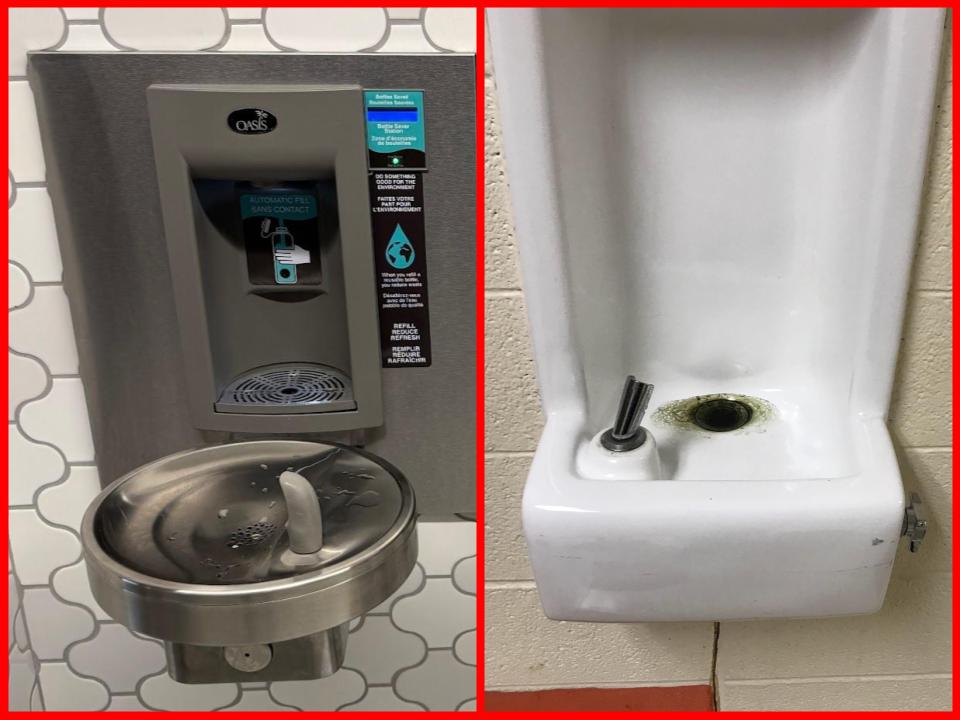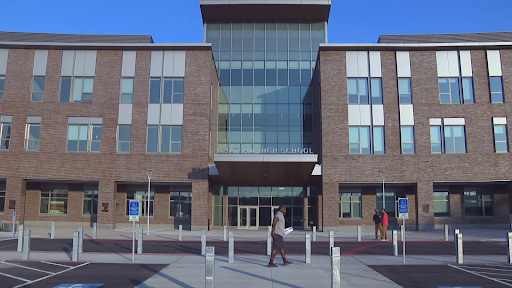Our old high school building at 617 Lexington is older than the Safe Drinking Water Act of 1986, so streaks of color staining our water fountains helped spread rumors about the quality of our drinking water. I’ve heard speculation among both students and teachers about our water fountains being unsafe. While we’re in a new building this year at 554 Lexington with new plumbing and top-notch water filtration systems, there are still people who don’t trust the potability of our drinking water. The continued distrust in the quality of our drinking water begs the question: How does the new school compare to the old?
Before answering this question, I have to make sure you understand why such rumors were so widespread in the old building: The water fountains were nasty. It was common to find a green film over the metal parts of a given water fountain and a majority of the water fountains had orange staining in the ceramics. Additionally, most water fountains had an orange streak running down the wall beneath them. Rumors claimed that this was evidence of contaminants, and there was a bit of basis for the claim.
The orange streaks and staining could be caused by high iron concentration in the water and the green film was most likely due to a high concentration of copper. For the streaks, the leading theory was that the water fountains leaked and iron accumulated over time to form rust. The most likely candidate for the green film is copper buildup as the water came out of the fountains, and the copper would oxidize to make the green color.
Waltham’s Water Testing
It is important to keep in mind that all Waltham schools’ water was tested in 2021 and Waltham gets annual water testing by the Massachusetts Water Resources Authority, which also includes testing a random school. All reported tests came back within acceptable levels, both school and city-wide. Since most damage from the types of contaminants in question happens through long-term exposure, any issue with the water quality under this system of annual testing should be found before it becomes a major safety concern.
Commercial Water Tests
Commercial water tests usually come in the form of long, thin paper strips with small squares of chemical activators spaced out a little. After dipping the strip in water for around two seconds and then waiting for the colors to change (about fifteen more seconds), the colors will change based on the amount of a given material in the sample and you compare the strip to a printed chart that is included in the testing kit. In October 2023, I ran our school’s water through sixteen tests: water hardness (concentration of minerals in the water), free chlorine, iron, copper, lead, nitrate, nitrite, microplastics, total chlorine, fluoride, cyanuric acid, chlorine dioxide, QAC/QUAT, alkalinity, carbonate, and pH. This year in March, I tested our school’s water with a test strip that contained sixteen tests: water hardness, free chlorine, iron, mercury, total chlorine, copper, lead, zinc, manganese, QAC/QUAT, fluoride, sodium chloride, hydrogen sulfide, alkalinity, carbonate, and pH.
Testing Our Water
Now that all of that is out of the way, I can tell you about the tests I took. At the 617 Lexington school site, I sampled water from three ceramic fountains (two were normal and one was covered with tape, a trash bag, and an ‘out of order’ sign), one metallic water fountain (next to the gym), and the water dispenser in the floor’s House Office. If you still remember the layout of the old school, you might be able to figure out that these are all of the water fountains on the second floor. Across the board, water tests showed normal concentrations of iron, copper, chlorine, nitrate, nitrite, fluoride, and pH. All but one showed no amount of lead. The outlier in this test is one of the ceramic fountains (2nd floor, odd-lower number side of the building if you remember how the room numbering worked) which showed some amount of lead. Lead in drinking water is always a bad thing, but thankfully this was the water fountain that was covered and marked ‘out of order’, so nobody was drinking from it. This is also proof that the school was regularly testing the water since they caught the problem before it could damage anyone. For the rest of the tests, carbonate and QUAT concentrations were slightly high, but were not high enough to affect the potability of drinking water. Overall, the water sources people actually drink from were completely safe, but the theories behind the green film and orange staining are not directly supported by the normal copper and iron levels.
This February, I tested the first and second floor water fountains at the new high school site at 554 Lexington. I got every water fountain except for the one in the yellow (early education) wing on the first floor. I only tested the water bubblers and not the bottle dispensers, but they’re all attached to the same piping so one should have the same results as the other. The test results across all tested fountains were consistent and well within normal levels apart from the pH. Our water seems to be slightly acidic, but acidity doesn’t impact potability. Water acidity can affect the taste, odor, and corrosiveness of piping. Our school’s water is only slightly more acidic than normal levels with a pH of around 6.4, and levels of pH above that are generally considered to be personal preference rather than safety concern. Our new water would be considered ‘soft’ on the water hardness scale, which is a good thing for our piping. Overall, the water fountains on the first and second floor are safe to drink, so you shouldn’t be concerned about sourcing water during the day.
The new school’s water quality is better than the old school’s, probably because of the brand-new plumbing and the filtration system in every water fountain. Our fountains are safe to drink from, so students shouldn’t go thirsty because they question the potability of our drinking water anymore.






